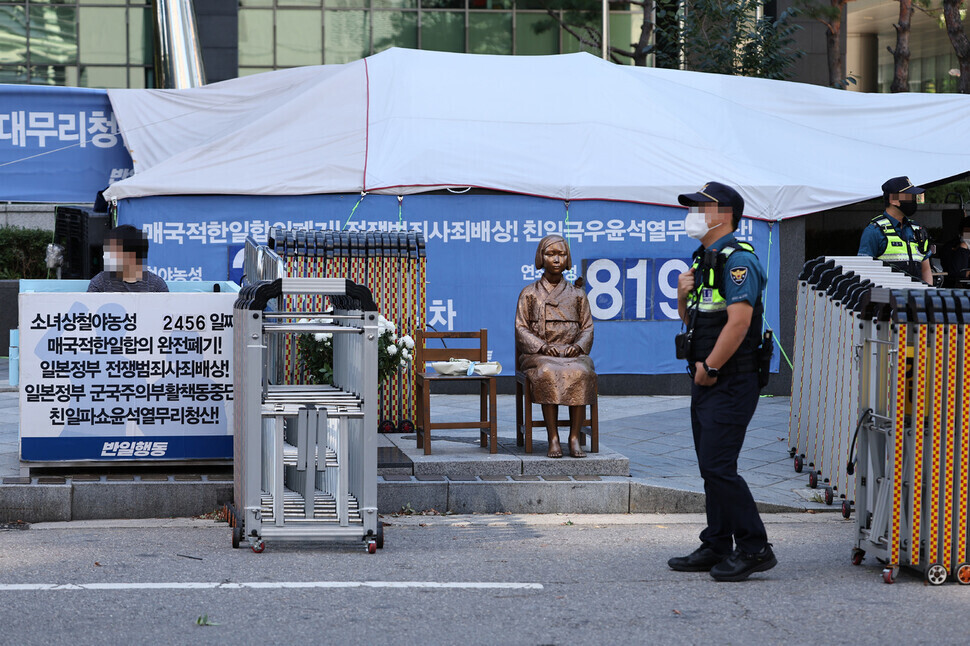hankyoreh
Links to other country sites 다른 나라 사이트 링크
[Editorial] Japan’s rewriting of history with Korea has gone too far

Japan’s authorization of middle school history textbooks that passed additional screenings on Friday is truly shocking. It’s a violent affront to the understanding that South Korea and Japan have shown each other, in spite of all their disagreements regarding history.
The Yoon Suk-yeol administration needs to reexamine the kowtowing “self-degradation diplomacy” strategy it has adopted for the past two years, and how such a strategy has allowed such a gross and blatant historical distortion from Japan. The administration also needs to overhaul its foreign policy on Japan.
Last week, Japan’s Education Ministry approved a history textbook designed for second-year students in middle school by publisher Reiwa Shoseki, despite the book’s far-right, retrogressive statements.
“We have judged that there is no problem,” the ministry said while announcing the approval. The text’s most shocking distortions involve the Japan-Korea Treaty of 1905, known locally as the Eulsa Treaty locally, and the “comfort women” forced into sexual slavery.
While Japan has always defended the legality of its occupation and colonization of Korea, it has never gone so far as to openly state that Koreans wanted the occupation or that colonial rule was “just.” In 2010, for instance, Japanese Prime Minister Naoto Kan acknowledged Japan’s “colonial rule which was imposed against [Koreans’] will.”
This latest textbook, however, claims that King Gojong, the last Korean monarch, was “satisfied” with the Japan-Korean Treaty of 1905 that stripped Korea of its sovereignty. It goes farther to assert that Gojong went out of his way to persuade members of his government who opposed the treaty into signing it.
The text cites the report that Hirobumi Ito, the first prime minister of Japan, sent to the Japanese emperor on Dec. 8, 1905, after forcing Gojong to sign the treaty. Yet even the Japanese historians who insist on the “procedural legality” of the treaty acknowledge that Gojong essentially had no choice but to sign it.
Fukuju Unno, a Japanese historian and professor emeritus at Meiji University, is a prominent advocate of the assertion that Japan’s colonial rule was legal. In research Unno published in 2000, he states that Gojong “made sure the treaty included a date of expiration, at which point Korea would recover at least a part of its diplomatic rights.”
Ito, however, took advantage of this and considered the fact that he had accepted the emperor’s request and revised the treaty as evidence of his approval, Unno writes.
The text basically cites Ito’s deception as evidence of Gojong’s consent, in a deplorable distortion of history.
While Japan has avoided taking legal responsibility for the comfort women issue, it has still acknowledged that the Japanese military had “involvement” in the transport, management and administration of sex slaves in a “grave affront to the honor and dignity of large numbers of women” in the 2015 agreement on the matter.
The Reiwha Shoseki text, however, boldly claims that the comfort women were paid workers who were justly compensated for their labor. It does not acknowledge any wrongdoing whatsoever on the part of the Japanese authorities. Reiwha Shoseki’s text failed the Education Ministry’s screenings in 2020 and 2021, so why was it approved this year? This is not something that can be solved by simply summoning the Japanese ambassador for a quick chat and superficial reprimand.
Please direct questions or comments to [english@hani.co.kr]

Editorial・opinion
![[Editorial] Penalties for airing allegations against Korea’s first lady endanger free press [Editorial] Penalties for airing allegations against Korea’s first lady endanger free press](https://flexible.img.hani.co.kr/flexible/normal/500/300/imgdb/original/2024/0502/1817146398095106.jpg) [Editorial] Penalties for airing allegations against Korea’s first lady endanger free press
[Editorial] Penalties for airing allegations against Korea’s first lady endanger free press![[Editorial] Yoon must halt procurement of SM-3 interceptor missiles [Editorial] Yoon must halt procurement of SM-3 interceptor missiles](https://flexible.img.hani.co.kr/flexible/normal/500/300/imgdb/child/2024/0501/17145495551605_1717145495195344.jpg) [Editorial] Yoon must halt procurement of SM-3 interceptor missiles
[Editorial] Yoon must halt procurement of SM-3 interceptor missiles- [Guest essay] Maybe Korea’s rapid population decline is an opportunity, not a crisis
- [Column] Can Yoon steer diplomacy with Russia, China back on track?
- [Column] Season 2 of special prosecutor probe may be coming to Korea soon
- [Column] Park Geun-hye déjà vu in Yoon Suk-yeol
- [Editorial] New weight of N. Korea’s nuclear threats makes dialogue all the more urgent
- [Guest essay] The real reason Korea’s new right wants to dub Rhee a founding father
- [Column] ‘Choson’: Is it time we start referring to N. Korea in its own terms?
- [Editorial] Japan’s rewriting of history with Korea has gone too far
Most viewed articles
- 160% of young Koreans see no need to have kids after marriage
- 2Presidential office warns of veto in response to opposition passing special counsel probe act
- 3Hybe-Ador dispute shines light on pervasive issues behind K-pop’s tidy facade
- 4Months and months of overdue wages are pushing migrant workers in Korea into debt
- 5[Editorial] Penalties for airing allegations against Korea’s first lady endanger free press
- 6Japan says it’s not pressuring Naver to sell Line, but Korean insiders say otherwise
- 7OECD upgrades Korea’s growth forecast from 2.2% to 2.6%
- 8Bills for Itaewon crush inquiry, special counsel probe into Marine’s death pass National Assembly
- 9[Guest essay] Maybe Korea’s rapid population decline is an opportunity, not a crisis
- 10[Reporter’s notebook] In Min’s world, she’s the artist — and NewJeans is her art